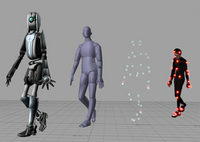3D computer graphics

Imagine you're playing with toy building blocks. You can stack them up to make towers, create different shapes by putting them together in different ways, and imagine all sorts of different structures. 3D computer graphics are kind of like that, but instead of physical blocks, it's all on a computer.
In 3D computer graphics, lots and lots of tiny shapes called polygons (or "polys" for short) are used to create three-dimensional objects. These objects can be anything from people, to cars, to planets, to whole cities!
The computer then has to figure out how to make those polygons look like real objects. This is done using something called texture mapping, which is a bit like putting a skin or a sticker on each polygon. This way, each polygon can have its own color or pattern, making it look like a part of the real object it represents.
Next, special computer programs called rendering engines work really hard to make the 3D objects look as realistic as possible. They do things like adding shadows, reflections, and lighting to make the objects look like they're in a real scene.
Once everything is put together, you end up with an image or animation that looks like a real 3D object! These graphics can be used in movies, video games, and other places where people want to make things look like they're really there, even though they're actually just pieces of code on a computer screen.
In 3D computer graphics, lots and lots of tiny shapes called polygons (or "polys" for short) are used to create three-dimensional objects. These objects can be anything from people, to cars, to planets, to whole cities!
The computer then has to figure out how to make those polygons look like real objects. This is done using something called texture mapping, which is a bit like putting a skin or a sticker on each polygon. This way, each polygon can have its own color or pattern, making it look like a part of the real object it represents.
Next, special computer programs called rendering engines work really hard to make the 3D objects look as realistic as possible. They do things like adding shadows, reflections, and lighting to make the objects look like they're in a real scene.
Once everything is put together, you end up with an image or animation that looks like a real 3D object! These graphics can be used in movies, video games, and other places where people want to make things look like they're really there, even though they're actually just pieces of code on a computer screen.
Related topics others have asked about:
